The following article is the first since I have builit my new killifish set-up after moving house. The species under the spotlight was my first acquisition after a lenghty time away from this niche side of the hobby. After my love affair with these colourful toothcarps was rekindled I tracked down this species to a local breeders fish-house, he duly let me have a pair and my maintenance and breeding notes can be followed below.
Aphyosemion elberti N'tui Ngorro Road
In the following article I will attempt to explain how I go about the day to day care and breeding of one of the more popular and colourful species of Killifish,
Namely the Ngorro Road population of Aphyosemion elberti (bualanum) N'tui.
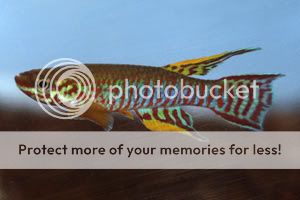
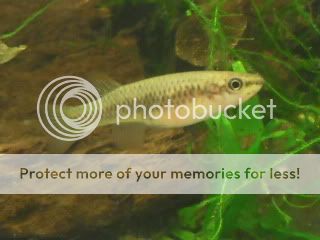
General
Although I have kept and bred this species before (possible different location) I had never put anything down on paper, re-acquiring this species again in August 2009 from a fellow BKA member has allowed me to address this.
This little jewel belongs to the Elberti grouping which consists of many locations in or around the Republic of Cameroon in Africa. The N'tui population originates from a town in central/western Cameroon north of Yaounde, and is found in areas bordering on rainforest. (see map)
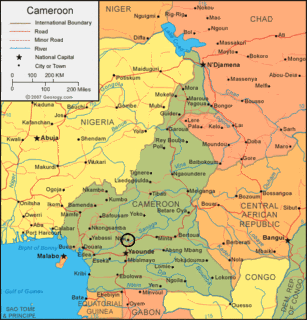
As always many of these rainforests like others around the globe are being harvested for timber products without any care for indigenous flora and fauna. These commercial ventures will soon strip this and surrounding areas of their natural plant animal and fish species for which the world will be a much poorer place.
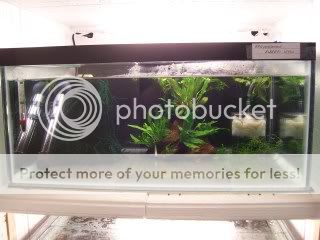
I find this species likes to be kept a little warmer than other populations going by the amount of eggs collected daily. As you can see from the above image their tank is furnished with some bogwood with Java Fern (Microsorum pteropus) attached and the surface area is now completely covered with floating plant (Salvinia natans). The more dimly lit the aquarium the more vibrant the colours of the killifish become. The obligatory acrylic spawning mops are also included in this set-up as this particular species of toothcarp is a plant spawner by nature. There is no substrate as this make for easier cleaning of the aquarium floor area. I have found this species does not take too readily to prepared foods but this is not a big deal as I prefer to feed livefood over flake and frozen given the choice. Their dietary needs are taken care of with a mixture of the following foodstuffs; Whiteworm, Fruitfly, Grindalworm, Brineshrimp and newly hatched Brineshrimp occasionally I would feed frozen Bloodworm. I like to feed a varied diet to this and all my killifish species.
Colouration
Male: In keeping with all Aphyosemions the male of the species is the most strikingly colourful fish of the pair. The main underlying colouration of the body is a deep shimmering aquamarine blue overlaid at the front of the body with prominent red blotches or dots. These blotches of red change to become irregular red vertical lines from just behind the pelvic fins all the way along the flanks, through the caudal peduncle and right to the end of the caudal fin.
The back of the male is dark tan in colour and the belly region is a silvery blue. The dorsal fin is pretty well set back on the elberti species it is coloured a greenish blue with red blotches or stripes the upper part of the fin id edged with yellow and red strip. The anal fin retains pretty much the same colouration of the dorsal with four or five vertical stripes of red and the outside edges laced with yellow and red bars. The pectoral and pelvic fins are reddish and edged with blue. The caudal fin has a very slight lyre extensions to the upper and lower lobes these are edged with blue and red strips.
Female: The female remains somewhat drab in comparison to the male On closer inspection you will notice that the overall body colouration is brownish grey. The back region being darker than the belly area which is silver. All her fins are pretty much clear but they are edged with an orange tinge. Under certain lighting the body of the female will posses rows of small red spots. The fins are more rounded in the female compared to the male.
Breeding
Aphyosemion elberti N'tui is a pretty much undemanding species of killifish providing its specific water requirements are met and good maintenance strategies are adhered to. They like to live in very clean water and 25% weekly water changes are one of the keys to success. I keep a pair in a small 18x15x9 glass tank complete with an air driven box filter. The water statistics are keenly checked and regulated to [ pH 7, dKH 2 - Temp 26'C ] Once these parameters are met they are what I would term as very prolific spawner's. Collecting 24-27 eggs per day is not uncommon from my well conditioned adult pair.
Spawning usually takes place in the mops and at all levels, the male will entice the female to a chosen spot in the mop and will wrap his dorsal and anal fins around the female and adopt a characteristic "S" shape then you will notice a sharp jerk, at this point the male will release the female and a single egg will have been deposited within the strands of the mop, it will remain there attached to the mop by an adhesive thread, until I harvest it and place it along with the many others into a small plastic tub.
Eggs and Fry Rearing
I believe that N'tui eggs are pretty robust and can be picked from the spawning mops daily and placed into small plastic tubs. I tried two methods of storage, they being, water incubation and incubation on a shallow layer of peat. Whilst the peat prolongs the incubation time a little I found no difference in hatching numbers or fungus problems from either method. I prefer to water incubate as after the first week it becomes pretty hard to see the eggs using the peat storage method.
The eggs of N'tui are pretty small being around 1.5mm in diameter. They are clear but darken in a few days as the embryo matures. The normal incubation time I found to be around 12-18 days, sometimes the fry are a little reluctant to hatch so the old vigorous agitation method has to be called into use. (Give the egg container a good shake)
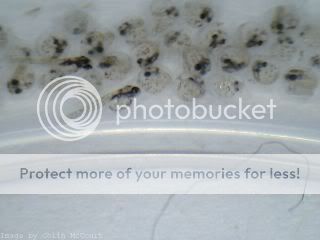
A batch of eggs, some of which have just hatched
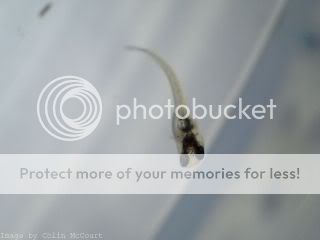
2 Hour old Aph.elberti N'tui fry
Once the fry hatch they are transferred into small margarine tubs. I place no more than 6-10 fry in each tub. That way if you have an accident or a problem with one tub at least you don't loose all your fry.
In my opinion these little fry may be too small to handle BBS straight away and not at least for some hours anyway. I have observed them, using the microscope, and for quite some time after hatching their bellies are not coloured orange which you would expect if they were taking this kind of food from the start. So I provide them with some plant matter in the tubs and a drop of Liquifry egglayer to help the infusorians along. After the second day it's pretty much business as usual and they are feeding on BBS normally. The fry tubs are kept very clean and are swapped every other day. 20% waterchanges daily is normal practice for me to be doing with this and most species of killifish fry I handle. with a full 100% waterchange weekly. I'm a dab hand at catching fish fry with the old pipettes. Performing such frequency of waterchanges (from a separate barren holding tank, no fish) I find that the fry really do grow fast. I feed the fry three to four times daily on a mixture of BBS, Microworm and Banana Worm. This constant feeding regime means that the cleanliness within the fry tubs is paramount. I always syphon off any dead or dying BBS and worms before any more food is administered. After around six weeks the fry are ready to be placed in larger tubs (1lb Ice Cream cartons) and water changes can still be maintained as above always remembering to maintain a clean as environment as possible for the fry
Summary
This is a pretty nice fish species to deal with and does not provide too much of a challenge as far as breeding goes. Providing the above criteria concerning water conditions are met then I would consider this species to be very prolific mop spawners. The eggs can be water or peat incubated but I feel they prefer to be in water to be honest. Fry are easy enough to rear but may need smaller food than newly hatched brineshrimp for a day or two after hatching. From then on is plain sailing so long as you keep things clean and perform regular waterchanges.
Breeding Overview
Tank size: 18"x15"x9"
Decor: Adults - bare tank with floating mops (dk green), Bogwood with Java Fern and Java Moss attached and Salvinia covering the surface, Fry - Java Moss
Water: Soft & Slightly Acidic 36-40 TDS (2dKH) - pH 7
Temperature: 26'C
Waterchanges: Weekly (40%) for Breeders and Daily (20%) for Fry tubs removing uneaten food. Also a total 100% waterchange weekly.
Filtration: Air driven box filter, floss with added peat and Indian almond leaf.
Feeding: little and often especially fry, remember to syphon off uneaten food.
Lighting: artificial lighting.
If the adults are well fed they don't seem to bother any fry that appear in the parent tank. I have noticed larger fry chasing their saller siblings to a certain extent but have never witnessed the actual cannibalistic act.
Remember
Tight fitting lid is essential as with all killifish species.
Again...Thank you for taking the time to read through this long and informative article, I hope it will help someone starting out to keep killifish and also hobbyists who are having difficulty with this species.
Regards
BigC
Aphyosemion elberti N'tui Ngorro Road
In the following article I will attempt to explain how I go about the day to day care and breeding of one of the more popular and colourful species of Killifish,
Namely the Ngorro Road population of Aphyosemion elberti (bualanum) N'tui.


General
Although I have kept and bred this species before (possible different location) I had never put anything down on paper, re-acquiring this species again in August 2009 from a fellow BKA member has allowed me to address this.
This little jewel belongs to the Elberti grouping which consists of many locations in or around the Republic of Cameroon in Africa. The N'tui population originates from a town in central/western Cameroon north of Yaounde, and is found in areas bordering on rainforest. (see map)

As always many of these rainforests like others around the globe are being harvested for timber products without any care for indigenous flora and fauna. These commercial ventures will soon strip this and surrounding areas of their natural plant animal and fish species for which the world will be a much poorer place.

I find this species likes to be kept a little warmer than other populations going by the amount of eggs collected daily. As you can see from the above image their tank is furnished with some bogwood with Java Fern (Microsorum pteropus) attached and the surface area is now completely covered with floating plant (Salvinia natans). The more dimly lit the aquarium the more vibrant the colours of the killifish become. The obligatory acrylic spawning mops are also included in this set-up as this particular species of toothcarp is a plant spawner by nature. There is no substrate as this make for easier cleaning of the aquarium floor area. I have found this species does not take too readily to prepared foods but this is not a big deal as I prefer to feed livefood over flake and frozen given the choice. Their dietary needs are taken care of with a mixture of the following foodstuffs; Whiteworm, Fruitfly, Grindalworm, Brineshrimp and newly hatched Brineshrimp occasionally I would feed frozen Bloodworm. I like to feed a varied diet to this and all my killifish species.
Colouration
Male: In keeping with all Aphyosemions the male of the species is the most strikingly colourful fish of the pair. The main underlying colouration of the body is a deep shimmering aquamarine blue overlaid at the front of the body with prominent red blotches or dots. These blotches of red change to become irregular red vertical lines from just behind the pelvic fins all the way along the flanks, through the caudal peduncle and right to the end of the caudal fin.
The back of the male is dark tan in colour and the belly region is a silvery blue. The dorsal fin is pretty well set back on the elberti species it is coloured a greenish blue with red blotches or stripes the upper part of the fin id edged with yellow and red strip. The anal fin retains pretty much the same colouration of the dorsal with four or five vertical stripes of red and the outside edges laced with yellow and red bars. The pectoral and pelvic fins are reddish and edged with blue. The caudal fin has a very slight lyre extensions to the upper and lower lobes these are edged with blue and red strips.
Female: The female remains somewhat drab in comparison to the male On closer inspection you will notice that the overall body colouration is brownish grey. The back region being darker than the belly area which is silver. All her fins are pretty much clear but they are edged with an orange tinge. Under certain lighting the body of the female will posses rows of small red spots. The fins are more rounded in the female compared to the male.
Breeding
Aphyosemion elberti N'tui is a pretty much undemanding species of killifish providing its specific water requirements are met and good maintenance strategies are adhered to. They like to live in very clean water and 25% weekly water changes are one of the keys to success. I keep a pair in a small 18x15x9 glass tank complete with an air driven box filter. The water statistics are keenly checked and regulated to [ pH 7, dKH 2 - Temp 26'C ] Once these parameters are met they are what I would term as very prolific spawner's. Collecting 24-27 eggs per day is not uncommon from my well conditioned adult pair.
Spawning usually takes place in the mops and at all levels, the male will entice the female to a chosen spot in the mop and will wrap his dorsal and anal fins around the female and adopt a characteristic "S" shape then you will notice a sharp jerk, at this point the male will release the female and a single egg will have been deposited within the strands of the mop, it will remain there attached to the mop by an adhesive thread, until I harvest it and place it along with the many others into a small plastic tub.
Eggs and Fry Rearing
I believe that N'tui eggs are pretty robust and can be picked from the spawning mops daily and placed into small plastic tubs. I tried two methods of storage, they being, water incubation and incubation on a shallow layer of peat. Whilst the peat prolongs the incubation time a little I found no difference in hatching numbers or fungus problems from either method. I prefer to water incubate as after the first week it becomes pretty hard to see the eggs using the peat storage method.
The eggs of N'tui are pretty small being around 1.5mm in diameter. They are clear but darken in a few days as the embryo matures. The normal incubation time I found to be around 12-18 days, sometimes the fry are a little reluctant to hatch so the old vigorous agitation method has to be called into use. (Give the egg container a good shake)

A batch of eggs, some of which have just hatched

2 Hour old Aph.elberti N'tui fry
Once the fry hatch they are transferred into small margarine tubs. I place no more than 6-10 fry in each tub. That way if you have an accident or a problem with one tub at least you don't loose all your fry.
In my opinion these little fry may be too small to handle BBS straight away and not at least for some hours anyway. I have observed them, using the microscope, and for quite some time after hatching their bellies are not coloured orange which you would expect if they were taking this kind of food from the start. So I provide them with some plant matter in the tubs and a drop of Liquifry egglayer to help the infusorians along. After the second day it's pretty much business as usual and they are feeding on BBS normally. The fry tubs are kept very clean and are swapped every other day. 20% waterchanges daily is normal practice for me to be doing with this and most species of killifish fry I handle. with a full 100% waterchange weekly. I'm a dab hand at catching fish fry with the old pipettes. Performing such frequency of waterchanges (from a separate barren holding tank, no fish) I find that the fry really do grow fast. I feed the fry three to four times daily on a mixture of BBS, Microworm and Banana Worm. This constant feeding regime means that the cleanliness within the fry tubs is paramount. I always syphon off any dead or dying BBS and worms before any more food is administered. After around six weeks the fry are ready to be placed in larger tubs (1lb Ice Cream cartons) and water changes can still be maintained as above always remembering to maintain a clean as environment as possible for the fry
Summary
This is a pretty nice fish species to deal with and does not provide too much of a challenge as far as breeding goes. Providing the above criteria concerning water conditions are met then I would consider this species to be very prolific mop spawners. The eggs can be water or peat incubated but I feel they prefer to be in water to be honest. Fry are easy enough to rear but may need smaller food than newly hatched brineshrimp for a day or two after hatching. From then on is plain sailing so long as you keep things clean and perform regular waterchanges.
Breeding Overview
Tank size: 18"x15"x9"
Decor: Adults - bare tank with floating mops (dk green), Bogwood with Java Fern and Java Moss attached and Salvinia covering the surface, Fry - Java Moss
Water: Soft & Slightly Acidic 36-40 TDS (2dKH) - pH 7
Temperature: 26'C
Waterchanges: Weekly (40%) for Breeders and Daily (20%) for Fry tubs removing uneaten food. Also a total 100% waterchange weekly.
Filtration: Air driven box filter, floss with added peat and Indian almond leaf.
Feeding: little and often especially fry, remember to syphon off uneaten food.
Lighting: artificial lighting.
If the adults are well fed they don't seem to bother any fry that appear in the parent tank. I have noticed larger fry chasing their saller siblings to a certain extent but have never witnessed the actual cannibalistic act.
Remember
Tight fitting lid is essential as with all killifish species.
Again...Thank you for taking the time to read through this long and informative article, I hope it will help someone starting out to keep killifish and also hobbyists who are having difficulty with this species.
Regards
BigC

